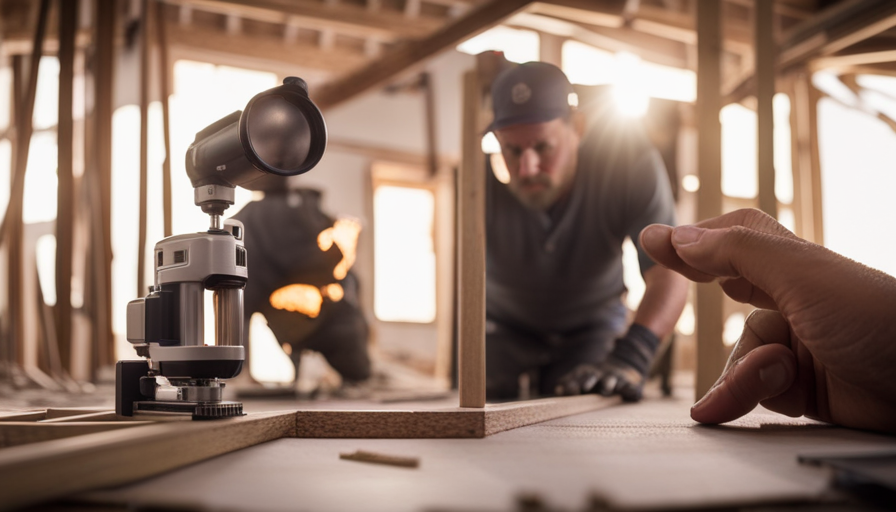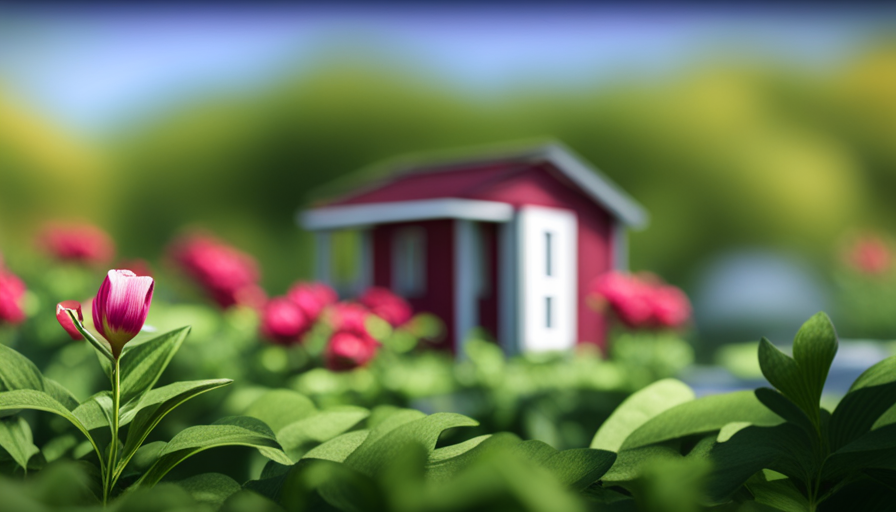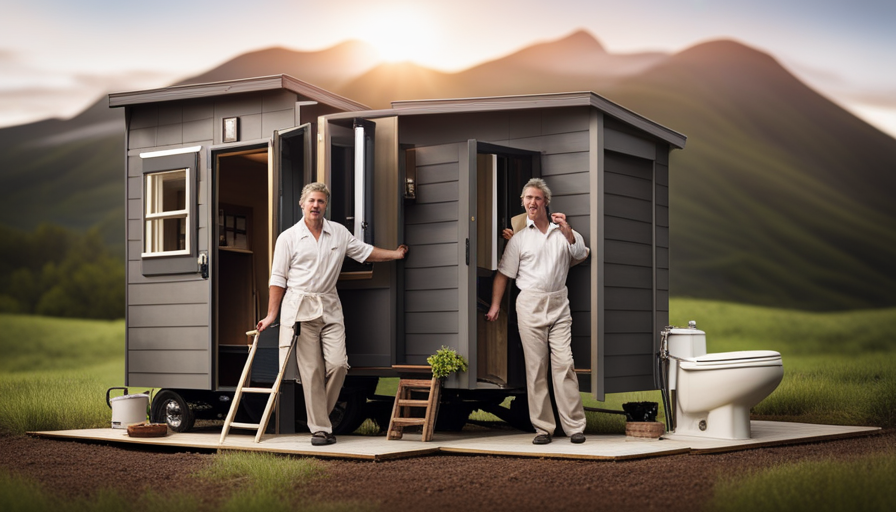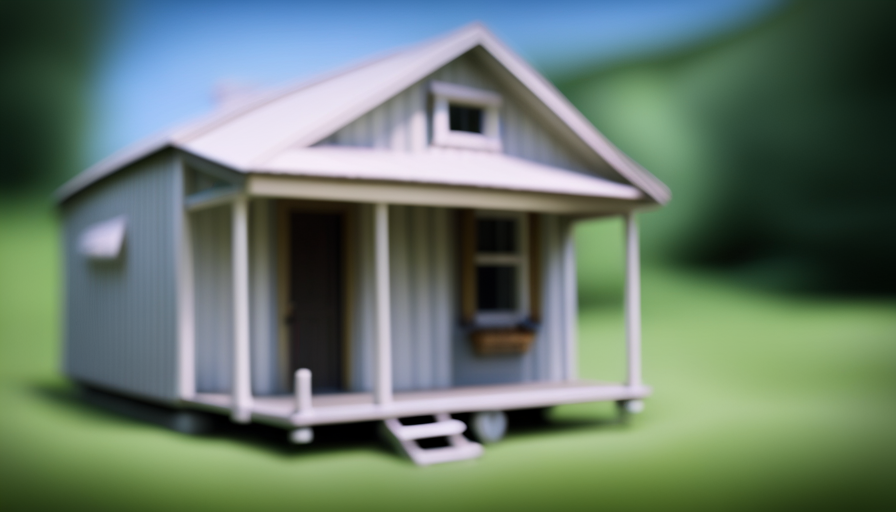Have you ever wondered how those charming tiny homes on wheels are made? Let me walk you through the captivating process of constructing a tiny house.
These diminutive dwellings, known for their space-saving ingenuity, are meticulously crafted using a combination of innovative techniques and expert craftsmanship. From the initial design and planning stages to the final touches, every step in the process is carefully executed to create a functional and aesthetically pleasing living space.
In this article, we will delve into the precise steps involved in building a tiny house. We’ll explore the foundation and framing, electrical and plumbing installation, insulation and weatherproofing, as well as the intricate process of interior finishes.
Additionally, we’ll uncover the complexities of HVAC system installation, windows and doors, and the limitless possibilities for customization and personalization.
So, join me as we unravel the secrets behind the creation of these extraordinary tiny abodes.
Key Takeaways
- The construction process of a tiny house includes initial design and planning, foundation and framing, electrical and plumbing installation, insulation and weatherproofing, interior finishes, and roofing and exterior finishes.
- Common materials used in tiny house construction include reclaimed wood, bamboo, and cork.
- Foundation installation can be done using a concrete slab or piers.
- Electrical and plumbing installation requires careful planning and adherence to safety standards.
Initial Design and Planning
Now you’re ready to start envisioning your dream tiny house and mapping out the floor plan that will perfectly suit your needs and maximize the limited space available.
The initial design process of a tiny house is crucial in ensuring that every inch of space is utilized efficiently. It starts with careful consideration of your lifestyle, needs, and preferences. Do you require a separate bedroom, or would a loft be sufficient? Will you need a dedicated workspace or storage area? These questions help determine the layout and flow of your tiny house.
Once you have a clear vision in mind, it’s time to move on to material selection. Choosing the right materials is essential for both functionality and aesthetics. Lightweight and durable materials are often preferred for tiny houses to minimize weight and maximize structural integrity. Common options include sustainable materials like reclaimed wood, bamboo, or cork, which not only contribute to a greener environment but also add a unique charm to your tiny house.
With the initial design process and material selection complete, you can now move on to the next phase of building your dream tiny house: the foundation and framing. This stage lays the groundwork for the structural integrity of your tiny house, and it is where your vision starts to take shape.
Foundation and Framing
First, the builders lay the foundation and frame the structure of the compact dwelling. The foundation installation is a crucial step in building a tiny house, as it provides stability and support for the entire structure. Typically, a concrete slab or piers are used as the foundation for a tiny house.
The builders carefully level the ground and pour the concrete, ensuring it’s properly cured before proceeding. Once the foundation is in place, the framing process begins. Framing techniques for tiny houses are similar to those used in traditional construction but on a smaller scale. The builders use precision measurements and high-quality lumber to create the frame, ensuring it’s strong and durable. They secure the frame together using nails, screws, or bolts, depending on the design.
The framing process involves carefully constructing the walls, roof, and floor, making sure they’re properly aligned and plumb. Once the foundation and framing are complete, the next step is electrical and plumbing installation. This allows for the integration of essential systems into the tiny house design seamlessly.
Electrical and Plumbing Installation
To ensure the seamless integration of essential systems into your compact dwelling design, you’ll need to investigate the truth of a theory about electrical and plumbing installation.
When it comes to electrical wiring in a tiny house, careful planning and adherence to safety standards are crucial. The electrical system should be designed to meet your specific power needs, taking into account the appliances and devices you plan to use. It is essential to consult a professional electrician to ensure that the wiring is properly installed and the load capacity is adequate.
In terms of plumbing fixtures, a tiny house requires a well-thought-out plumbing system that maximizes space efficiency. This includes installing water supply lines, drainage pipes, and fixtures such as sinks, showers, and toilets. Similar to electrical installation, it is recommended to seek the expertise of a plumber to ensure proper installation and compliance with building codes.
Once the electrical and plumbing systems are in place, the next step is to move on to insulation and weatherproofing. This is crucial for maintaining a comfortable indoor environment and protecting the structure from the elements.
Insulation and Weatherproofing
Creating a cozy and energy-efficient living space requires expert insulation and weatherproofing techniques. To ensure optimal insulation, several techniques can be employed.
Firstly, cavity wall insulation involves filling the gaps between the inner and outer walls with insulating materials such as fiberglass or foam. This method prevents heat loss and reduces energy consumption.
Additionally, roof insulation is vital for maintaining a comfortable interior temperature. Installing materials like mineral wool or rigid foam insulation boards under the roof can effectively prevent heat transfer.
Lastly, floor insulation is essential for thermal efficiency. By placing insulating materials, such as polystyrene or polyurethane foam, under the flooring, heat loss through the ground is minimized.
To guarantee a weatherproof tiny house, suitable materials and techniques must be employed. Waterproofing the exterior walls can be achieved by applying a weather-resistant barrier, such as a liquid-applied membrane or a self-adhering sheet, before installing sidings.
Similarly, ensuring a watertight roof involves using high-quality roofing materials, such as asphalt shingles or metal sheets, and properly sealing joints and edges.
Finally, sealing gaps and cracks around windows and doors with weatherstripping helps prevent drafts and water leakage.
Moving on to the subsequent section about interior finishes, it is crucial to focus on creating a comfortable and visually appealing living space.
Interior Finishes
Now, imagine stepping into your dream home, where every detail of the interior finishes has been carefully chosen to create a warm and inviting atmosphere. When it comes to tiny house construction, interior finishes play a crucial role in maximizing the functionality and aesthetic appeal of the limited space.
Unique materials are often used to add character and charm to the interior. From reclaimed wood accents to recycled glass countertops, these materials not only contribute to the sustainability of the tiny house but also create a one-of-a-kind look.
Additionally, color schemes are carefully selected to enhance the visual perception of space. Light and neutral tones are commonly used to make the interior appear larger, while pops of vibrant colors can be incorporated to add personality and visual interest.
By combining unique materials and thoughtful color schemes, the interior finishes of a tiny house can transform it into a cozy and stylish living space.
As we transition to the next section on roofing and exterior finishes, we will explore how these elements further contribute to the overall design and functionality of a tiny house.
Roofing and Exterior Finishes
When it comes to installing the roof on a tiny house, it’s crucial to choose the right materials and ensure a proper installation process. This includes selecting a durable and weather-resistant roofing material, such as asphalt shingles or metal panels, and ensuring that it’s installed correctly to prevent any leaks or water damage.
Additionally, the siding and exterior paint of a tiny house play a crucial role. They protect the structure from the elements and enhance its overall aesthetic appeal. It’s important to choose a siding material that’s durable, low-maintenance, and visually appealing. Also, applying a high-quality exterior paint that can withstand the outdoor elements for an extended period of time is essential.
Installing the Roof
To ensure proper insulation, it’s essential to install the roof correctly in a tiny house. When it comes to tiny house roofing techniques, there are several options to consider.
One common approach is to use a metal roof, which offers durability and longevity. Metal roofs are lightweight and easy to install, making them a popular choice among tiny house builders.
Another option is to use asphalt shingles, which are more affordable but may require more maintenance over time. When comparing roof materials, it’s important to consider factors such as cost, weight, and maintenance requirements.
Moving on to the next step, after the roof is installed, it’s time to focus on the siding and exterior paint.
Siding and Exterior Paint
After the roof is installed, the siding and exterior paint are like the finishing touches on a canvas, adding depth and character to the tiny abode.
Siding installation is a crucial step in the construction process of a tiny house. It not only protects the structure from the elements but also enhances its aesthetic appeal. There are various materials to choose from, such as vinyl, wood, or metal. Each material has its own advantages and disadvantages, so it’s important to consider factors like cost, durability, and maintenance requirements when making a decision.
Once the siding is in place, choosing the right exterior paint colors can make a huge difference in the overall look of the tiny house. It’s important to select colors that complement the surrounding landscape and reflect your personal style. The right combination of colors can make the house blend in seamlessly with its surroundings or stand out as a unique statement piece.
As the siding and exterior paint are completed, the tiny house starts to come to life, ready to welcome its future inhabitants.
Now, let’s move on to the next step, which is the installation of the HVAC system.
HVAC System Installation
Once the foundation is in place, it’s time to install the HVAC system in a tiny house. The HVAC system is an essential component of any home, including tiny houses. It not only provides comfort by regulating the temperature but also ensures proper ventilation and air quality. In a tiny house, where space is limited, it becomes even more crucial to choose an HVAC system that is compact and efficient.
When it comes to HVAC system maintenance in tiny houses, regular inspections and cleaning are necessary to keep it functioning optimally. This includes checking filters, cleaning ducts, and ensuring proper airflow. Additionally, energy efficiency is a top priority in tiny houses. Therefore, selecting an HVAC system with a high energy efficiency rating is crucial to minimize energy consumption and reduce utility costs.
During the installation process, it is important to carefully plan the placement of the HVAC system to maximize space utilization. Compact units that can be mounted on walls or placed in unobtrusive areas are often preferred in tiny houses. Proper insulation and sealing of the system are also essential to prevent any air leaks that could compromise energy efficiency.
As we move on to the next section about windows and doors, it’s important to consider their impact on the overall energy efficiency of a tiny house.
Windows and Doors
Windows and doors play a crucial role in enhancing the energy efficiency and overall aesthetic appeal of a compact dwelling. When it comes to window installation, it’s important to choose the right type and size to ensure proper ventilation and natural light. The selection process should consider factors such as insulation, durability, and ease of maintenance.
Additionally, the placement of windows should be strategically planned to maximize views while minimizing heat gain or loss.
In terms of door selection, the focus should be on security, insulation, and space optimization. A durable and weather-resistant door is essential to protect the interior from harsh weather conditions. Additionally, the door should be properly insulated to prevent heat transfer and maintain a comfortable indoor temperature.
To create a rhythm and flow in the writing, here’s an unordered bullet list of 5 items related to windows and doors in tiny house construction:
- Double-pane windows with low-emissivity (Low-E) coatings for improved insulation.
- Energy-efficient doors with weatherstripping and thermal breaks.
- Multi-functional windows, such as awning or casement windows, to maximize ventilation.
- High-quality window frames made from materials like vinyl or fiberglass for durability.
- Customizable door designs to suit personal preferences and architectural style.
With windows and doors carefully installed, the next step is to dive into the exciting realm of customization and personalization, where the tiny house truly becomes a unique and inviting home.
Customization and Personalization
After discussing the importance of windows and doors in a tiny house, let’s now delve into the exciting realm of customization and personalization. One of the greatest advantages of building a tiny house is the ability to tailor it to your specific needs and preferences.
Tiny house customization allows you to create a home that reflects your unique personality and lifestyle. When it comes to personalizing a tiny home, the possibilities are endless. You can choose from a wide range of interior finishes, such as flooring, cabinetry, and countertops, to create the aesthetic that resonates with you. Additionally, you can customize the layout to optimize the use of space and accommodate your specific requirements.
Whether you need a designated workspace, a cozy reading nook, or additional storage solutions, the design of your tiny house can be tailored to meet your needs. Furthermore, personalization extends beyond the interior. You can add your personal touch to the exterior by selecting the color scheme, siding material, and even incorporating unique architectural elements. From rustic and cozy to sleek and modern, the choice is yours.
As we move towards the final touches and move-in phase, the process of bringing your customized tiny house to life becomes even more exciting.
Final Touches and Move-In
As you step over the threshold of your carefully crafted abode, the final touches and move-in process envelops you in a whirlwind of excitement and anticipation. Before settling in, it is essential to ensure that everything is in order. A move-in checklist will help you stay organized and ensure that all tasks are completed. Here is a table outlining the main items to consider:
| Task | Description | Status |
|---|---|---|
| Utilities Setup | Arrange for electricity, water, and gas services | ✔️ |
| Cleaning | Thoroughly clean every nook and cranny | ✔️ |
| Furniture Arrangement | Plan the layout and arrange furniture | ✔️ |
| Decorations | Add personal touches with artwork and plants | ✔️ |
Once the essentials are taken care of, you can focus on decorating your new tiny house. The limited space calls for creative solutions. Consider utilizing multi-functional furniture, such as storage ottomans or fold-out tables. Mirrors can create an illusion of added space, while strategically placed shelves can maximize storage. Experiment with colors to create a cozy atmosphere. Lighter shades can make the space feel larger, while pops of vibrant colors can add personality. Lastly, don’t forget to hang curtains or blinds for privacy and to control natural light. By following these tips and incorporating your own decorating ideas, you can transform your tiny house into a comfortable and personalized haven.
Frequently Asked Questions
How much does it cost to build a tiny house?
The cost of building a tiny house depends on several factors such as size, materials used, and location. However, a rough cost estimation for building a tiny house is around $20,000 to $50,000.
This includes budget planning for purchasing materials, hiring labor, and any additional costs such as permits and utilities. It’s important to carefully plan and consider all expenses to stay within budget when building a tiny house.
What are the legal requirements for living in a tiny house?
To live in a tiny house, certain legal requirements must be met. Zoning restrictions are an important consideration, as they determine where tiny houses can be located. It is essential to research local regulations and ensure compliance with building codes.
Additionally, insurance requirements should be taken into account to protect your investment. Consult with local authorities and insurance providers to understand the specific legal obligations and coverage needed for living in a tiny house.
Can I build a tiny house on my own or do I need to hire professionals?
In deciding whether to build a tiny house on your own or hire professionals, there are pros and cons to consider.
DIY (Do-It-Yourself) allows for cost savings and a sense of accomplishment, but it requires time, skills, and knowledge of building codes.
Hiring professionals ensures expertise and a smoother process, but it can be more expensive.
Ultimately, the choice depends on your capabilities, resources, and preferences.
Are there any specific building codes or regulations that apply to tiny houses?
Building code requirements and zoning regulations are essential factors to consider when building a tiny house. These regulations vary depending on the location, but they generally cover aspects such as minimum square footage, ceiling height, plumbing, electrical systems, and safety standards.
It’s crucial to research and understand the specific building codes and zoning regulations in your area to ensure compliance. Failing to meet these requirements may result in fines or the inability to legally occupy the tiny house.
Can a tiny house be easily moved from one location to another?
Moving a tiny house is like transporting a compact treasure chest. It can be easily hitched to a vehicle and transported to a new location.
This mobility has significant economic implications, as it allows homeowners to explore new job opportunities or live in different communities without the high costs of traditional home relocation. Moreover, the environmental impact is reduced, as the need for land development and new construction is minimized.
Conclusion
After countless hours of meticulous planning, skilled craftsmanship, and unwavering determination, my tiny house has finally come to life.
From the sturdy foundation and precise framing to the intricately installed electrical and plumbing systems, every step has been taken with utmost precision.
The insulation and weatherproofing ensure that my haven stands strong against the harshest elements.
The interior finishes, HVAC system, and carefully chosen windows and doors bring comfort and style to this petite abode.
With the final touches and personalized touches, it’s time to move in and make this tiny house a home.
Hi, I’m Emma. I’m the Editor in Chief of Tiny House 43, a blog all about tiny houses. While tree houses are often associated with childhood, they can be the perfect adult retreat. They offer a cozy space to relax and unwind, surrounded by nature. And since they’re typically built on stilts or raised platforms, they offer stunning views that traditional homes simply can’t match. If you’re looking for a unique and romantic getaway, a tree house tiny house might just be the perfect option.










